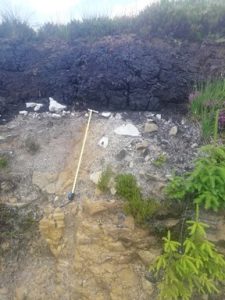
Blanket bogs are the most extensive of Ireland’s peatlands, originally covering an area of c.7750km2, and accounting for 8% of the world’s blanket bogs. But why exactly are they so important…?
Where did they come from?
Bogs represent compacted masses of unconsolidated organic matter derived from the accumulation of organic remains in water-logged environments. Blanket bog formation was initiated around the end of the last glaciation in Ireland, c.10,000 years ago. A climate of heavy rainfall at the time caused minerals to be leached from the surface layers of the soil and deposited deeper in the ground. At this depth they formed an impermeable layer, leading to the overlying soils becoming waterlogged, and allowing peat to accumulate and spread, ‘blanketing’ the grounds above.
Where are they found today?
Blanket bogs can be found where surface waters are acidic and low in nutrients, deriving most of their water from precipitation (hence why they are so abundant in Ireland!). Today, we have two types of blanket bogs in Ireland; Atlantic Blanket Bogs in low-lying western areas below 200mOD, and Mountain Blanket Bogs on relatively flat terrain in the higher mountainous regions above 200mOD.


Image Source: Irish Peatland Conservation Council website (www.ipcc.ie)
What makes them so important?
Well, here are just a few of the main reasons:
- They can inform us of the past to help plan for the future; the layers of peat that make up the blanket bogs preserve a record of regional vegetation change, climate change, atmospheric pollution, and can act as chronometers for other events such as volcanic eruptions.
- They are powerful climate regulators, accumulating and storing millions of tonnes of carbon and helping to control the greenhouse gases that cause destructive climate change. This preserved carbon can be released when boglands are artificially drained, which is why it is so important to keep peatlands wet.
- Blanket bogs are composed of over 90% water. This means they play a vital role as vast water reservoirs, contributing to the management of water within river catchments.
Blanket bogs lay claim to many other important roles, from providing specialised habitats for unique flora and fauna, to representing large areas of natural beauty. As such, the conservation, and, in many cases now, the remediation and recovery, of Ireland’s blanket bogs is of vital importance today.



